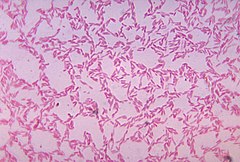Bacteroides
| Bacteroides | |
|---|---|
 |
|
| Bacteroides spp. anaerobically cultured in blood agar medium | |
| Scientific classification | |
| Kingdom: | Bacteria |
| Phylum: | Bacteroidetes |
| Class: | Bacteroidetes |
| Order: | Bacteroidales |
| Family: | Bacteroidaceae |
| Genus: |
Bacteroides Castellani & Chalmers 1919 |
| Species | |
Bacteroides is a genus of Gram-negative, obligate anaerobic bacteria. Bacteroides species are nonendospore-forming bacilli, and may be either motile or nonmotile, depending on the species. The DNA base composition is 40–48% GC. Unusual in bacterial organisms, Bacteroides membranes contain sphingolipids. They also contain meso-diaminopimelic acid in their peptidoglycan layer.
Bacteroides species are normally mutualistic, making up the most substantial portion of the mammalian gastrointestinal flora, where they play a fundamental role in processing of complex molecules to simpler ones in the host intestine. As many as 1010–1011 cells per gram of human feces have been reported. They can use simple sugars when available; however, the main sources of energy for Bacteroides species in the gut are complex host-derived and plant glycans. Studies indicate that long-term diet is strongly associated with the gut microbiome composition—those who eat plenty of protein and animal fats have predominantly Bacteroides bacteria, while for those who consume more carbohydrates the Prevotella species dominate.
One of the most important clinically is Bacteroides fragilis.
Bacteroides melaninogenicus has recently been reclassified and split into Prevotella melaninogenica and Prevotella intermedia.
...
Wikipedia
